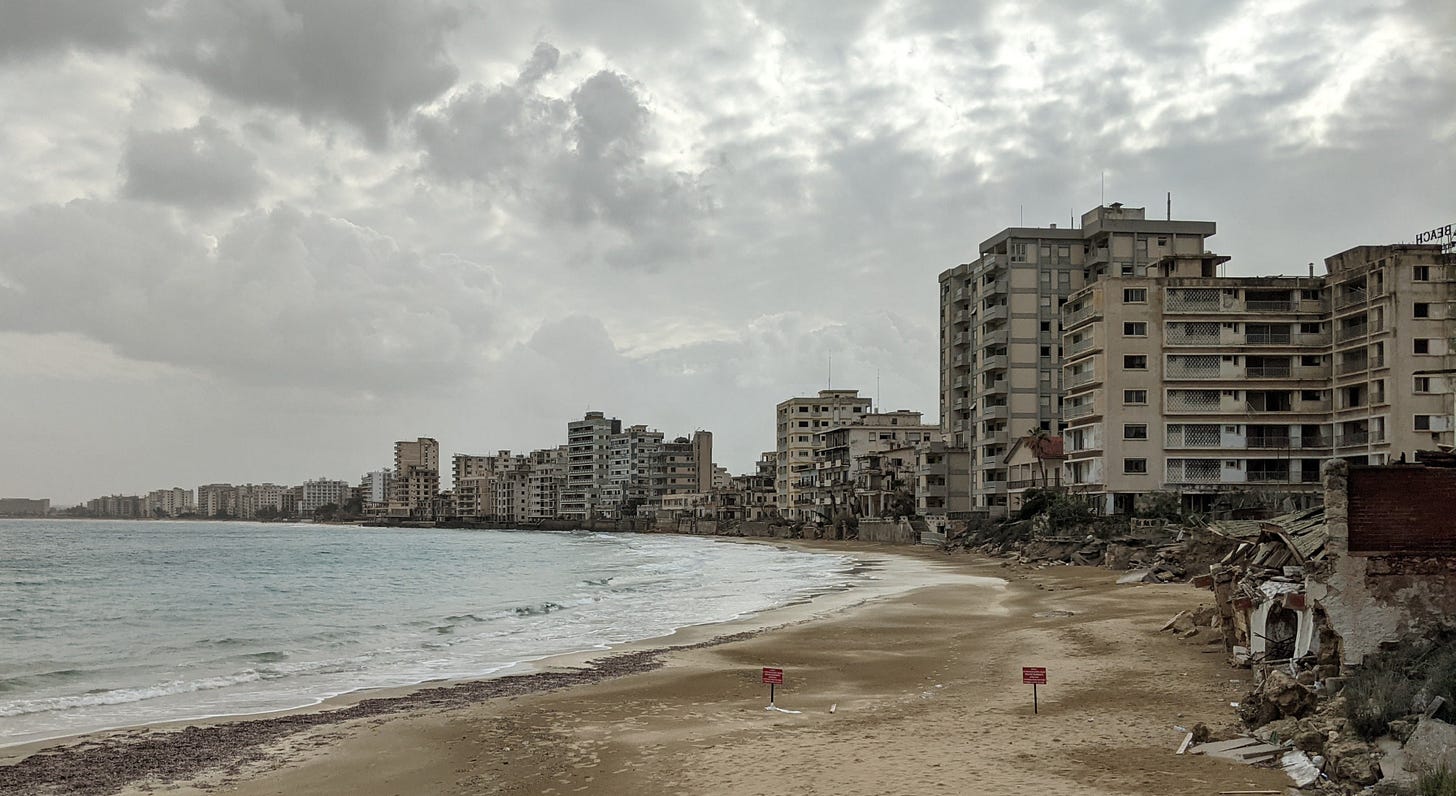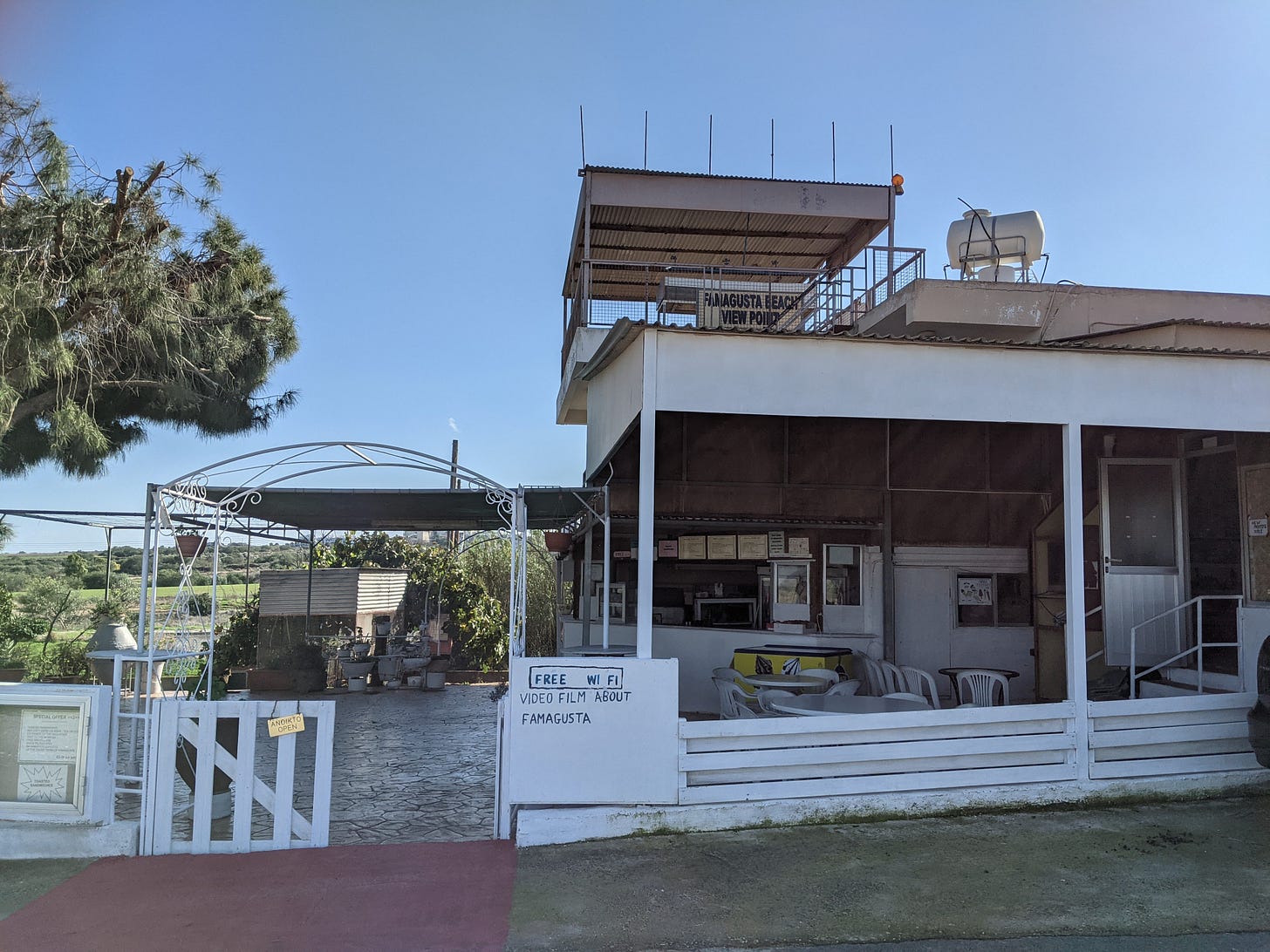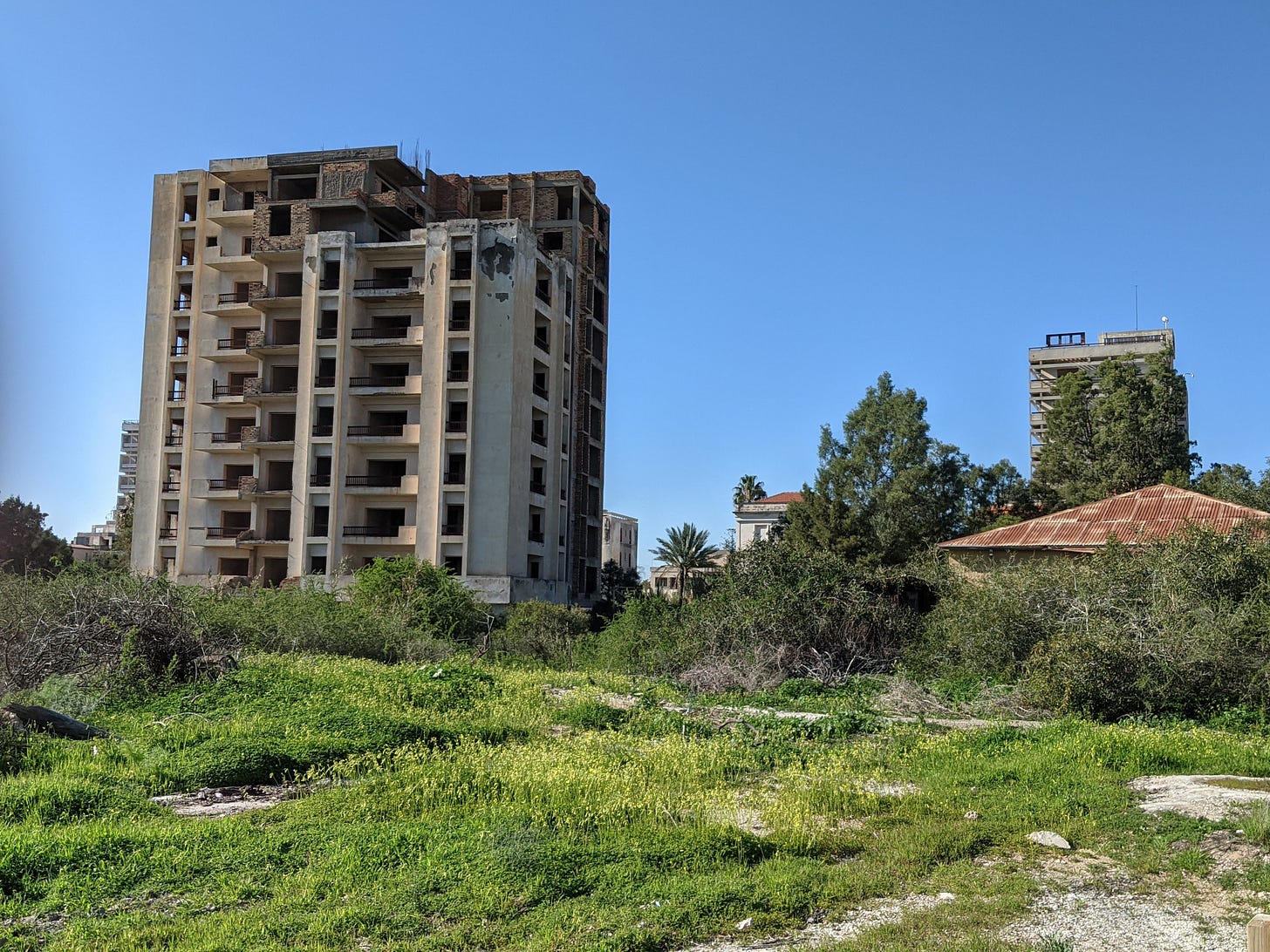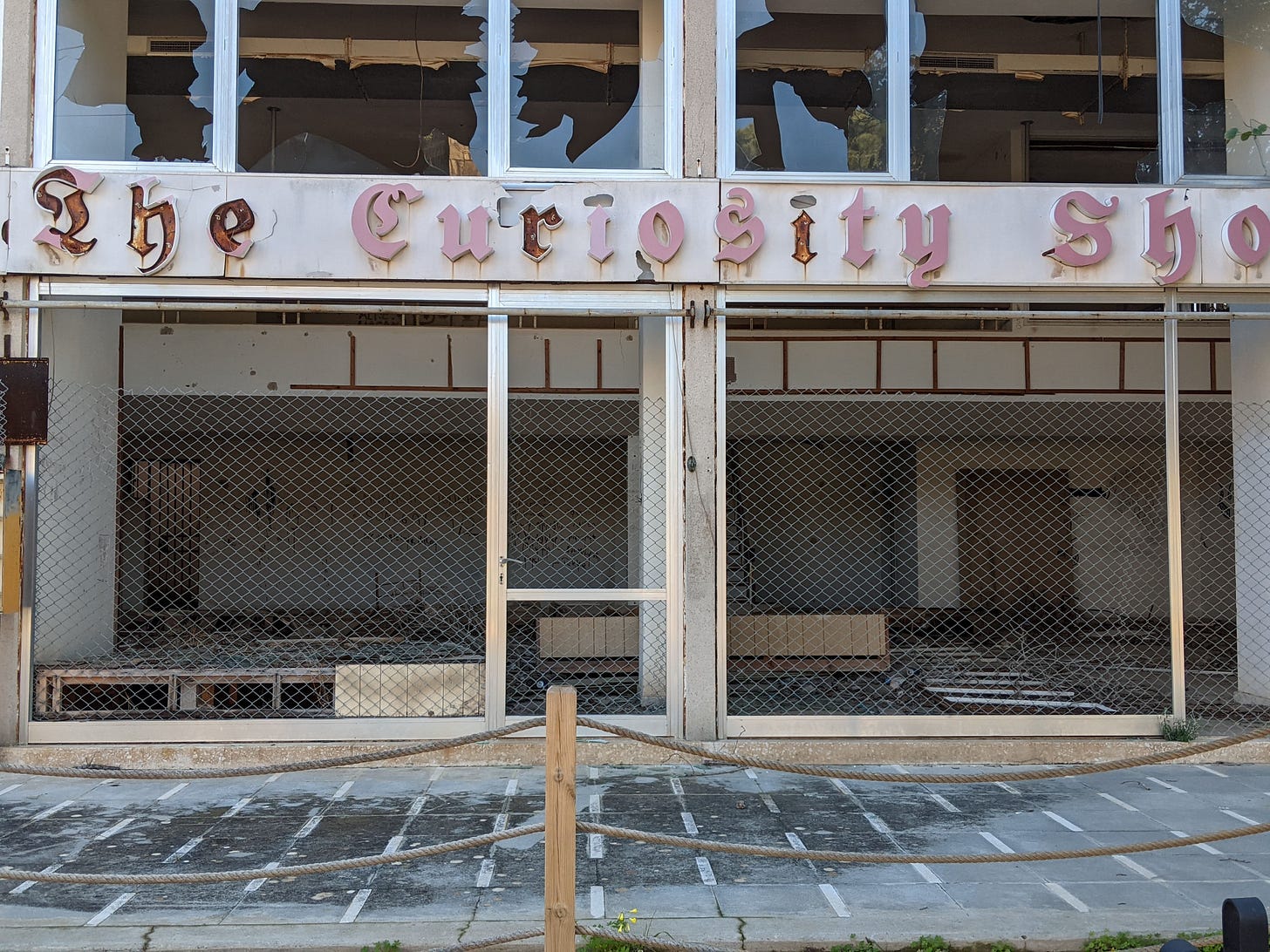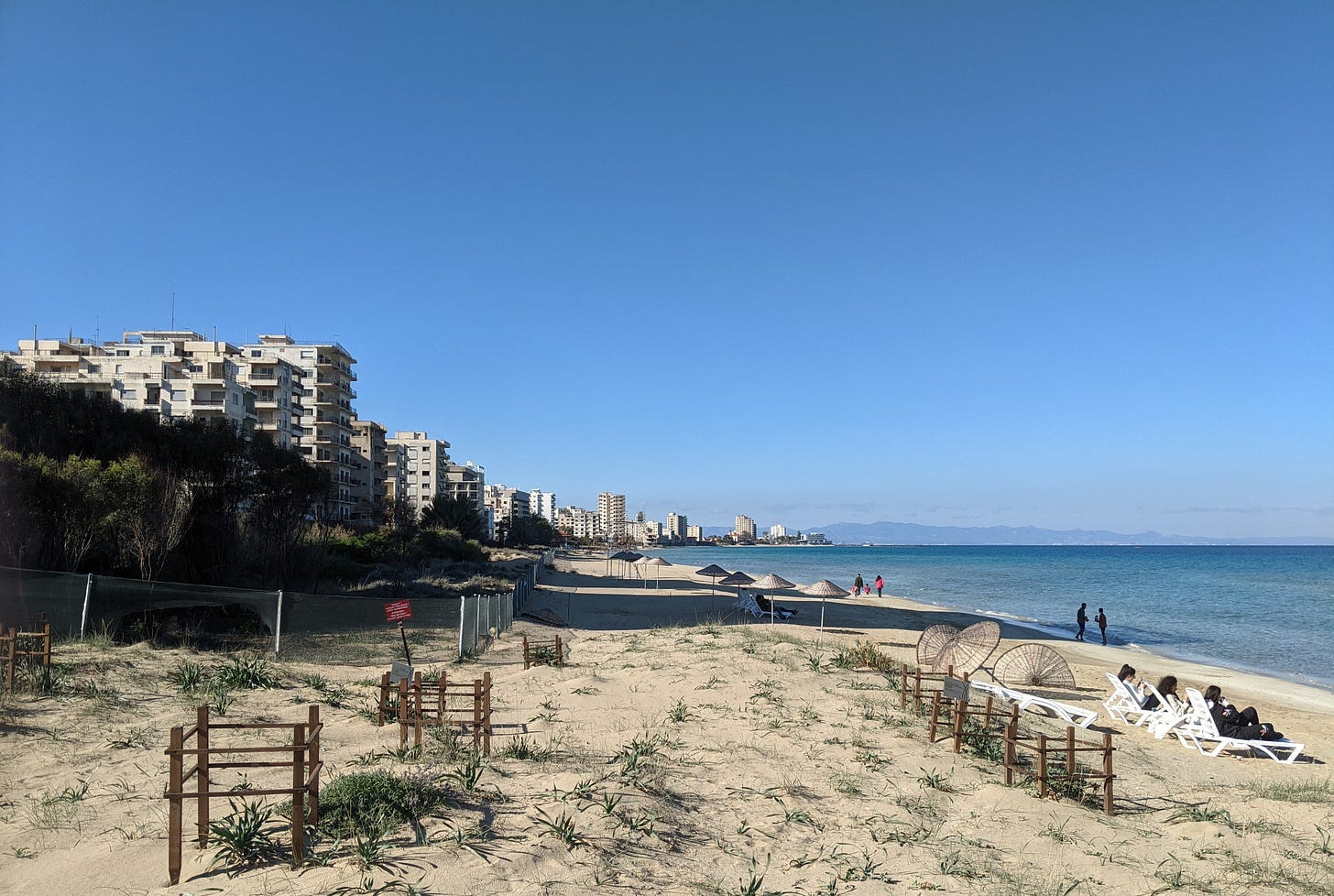Famagusta, the eco-city?
Famagusta Collage, Pt. IV: Looking ahead at the future of Varosha
I meant to wrap up my Famagusta series a long time ago, and I intended to time the publication with a 4,000 word story about the modern state of Famagusta, the principal outcome of my Fulbright research. However, that magazine went bankrupt as soon as I filed the story. I’m still looking for a new publisher. That piece will see the light of day eventually, but in the interest of closing loose ends, I wanted to conclude the Famagusta miniseries with a different chunk of research about Famagusta, about efforts to turn the abandoned city of Varosha into an “eco-city.” This is an excerpt of a presentation I gave at the 2022 Modern Greek Studies Association Symposium in Toronto.
At the edge of the Greek Cypriot municipality of Deryneia, a few blocks from the checkpoint that offers access through the UN Buffer Zone into the Turkish-occupied territory of Cyprus, is a macabre tourist destination. The so-called “Famagusta Viewpoint” is a classic example of “dark tourism,” a bungalow sitting at the edge of inhabited Deryneia and the abandoned, walled-off and militarized area to its north.
That area is of course the ghost city of Varosha. Those familiar with the modern Cypriot conflict are aware of the broad strokes of the tragic fate of Varosha, a thriving and modern Greek Cypriot community adjacent to old town Famagusta, that was in the 1960s the Miami Beach of Cyprus, boasting celebrity visitors like Elizabeth Taylor and Richard Burton. In 1974, following the coup in the Republic of Cyprus, the Turkish military invaded the island, and Varosha was abandoned by its fleeing Greek Cypriot inhabitants. As the occupation of the north of the island concretized into de facto partition, leading to the 1983 self-proclamation of the unrecognized “Turkish Republic of Northern Cyprus,” Varosha was walled off by the Turkish military and held as a bargaining chip in the endless peace negotiations. Varosha decayed in place, a grim reminder of that war.
Even in 2022, the Famagusta Viewpoint tourist site offers a glimpse at Varosha through a combined lens of nationalism and voyeurism. Pay a couple of euros for admission into the Viewpoint’s museum, and you might stroll through the viewpoint’s display of articles listing Turkish atrocities before ascending the rickety stairs to the roof, where you can make use of the worn binoculars included in your admission ticket to peer more closely at the restricted area beyond, the area that you’re not supposed to photograph. Through the lens you can see the hollowed-out, gray wrecks of hotels and apartments, seemingly stranded amidst sweeping fields of green, against the horizon of a cerulean sea. If this view somehow makes you hungry, downstairs the Viewpoint sells snacks and Nescafe.
The Viewpoint treats Varosha as it was for more than a generation—completely inaccessible, this elusive totemic place that could only be witnessed by standing atop a roof, with artificial magnification. But Varosha is no longer so—in 2020, thanks to the provocative actions of Turkish Cypriot leader Ersin Tatar, with the blessing of Turkish president Recep Tayyip Erdoğan, Varosha itself has taken on the dark tourism qualities of the Viewpoint which long lingered on its periphery.
This means that today, you can go to Palm Beach in Famagusta, pass through a guarded gate, where you’ll enter another, upside-down world. In this place, bikes can be rented, drinks and snacks are available for purchase, and you can walk along repaved and landscaped roads (complete with bike lanes). Just make sure to stay behind the ropes and heed the signs that warn that the surrounding buildings might fall on you at any moment. But apart from these measures, this ghost-town-as-amusement park is all yours—contrary to the rules outside Varosha, you can take as many photos as you like. You can even sunbathe or swim on the beach.
The Disneyfication of Varosha is an astonishing development. Its harshest critics might consider it akin to allowing people to skateboard on the 9/11 Memorial in New York. To turn what is a symbol of pain for respective Cypriot communities into a theme park is decidedly not the ideal vision of the many different stakeholders who would like to have a say in the future of Varosha, its status still firmly determined by the will of the Turkish authorities. The city remains encased in amber, its essential ingredients crystallized. But few can agree what should happen to Varosha if that fossil coating ever cracked.
Given the drama of Varosha’s predicament, the situation has motivated its fair share of moonshot plans. One such initiative proposed a radical reimagining of what Varosha could be—a vision that owes its origins to a chance interaction between Cypriot-American documentary filmmaker Vasia Markides, and Turkish Cypriot architect Ceren Boğaç.
Boğaç grew up in a house near the fence that enclosed Varosha. Before the war, her family was from Paphos, but in the aftermath they were resettled in Famagusta. After the Annan Plan failed, Boğaç went to Prague and taught at the Academy of Arts, Architecture & Design. One day she was browsing the internet and came across the title of a short documentary called “Hidden in the Sand,” an allusion to the meaning of Αμμόχωστος, the Greek origin for the name Famagusta. Boğaç wrote to the filmmaker asking if she could see the film. Two months later, Vasia Markides replied apologetically with the link, explaining she didn’t check the inbox very often.
Ceren watched the film and was surprised to find that Vasia, the American daughter of displaced Greek Cypriots, had interviewed many Turkish Cypriots she knew in Famagusta—including her father. The unexpected connection led to a correspondence, and an extended exchange. As it turned out, Vasia’s mother Emily was a permaculture professor at the University of Maine. Her dream was to conceive a new beginning for Famagusta as an “eco-city”—a city reimagined on sustainable lines for a greater connection between the built environment and its natural setting. But an eco-city could mean a lot of things, and what the Famagusta Eco-City Project in effect amounted to was trying to establish a consensus for a planning vision, and crafting a documentary about that process.
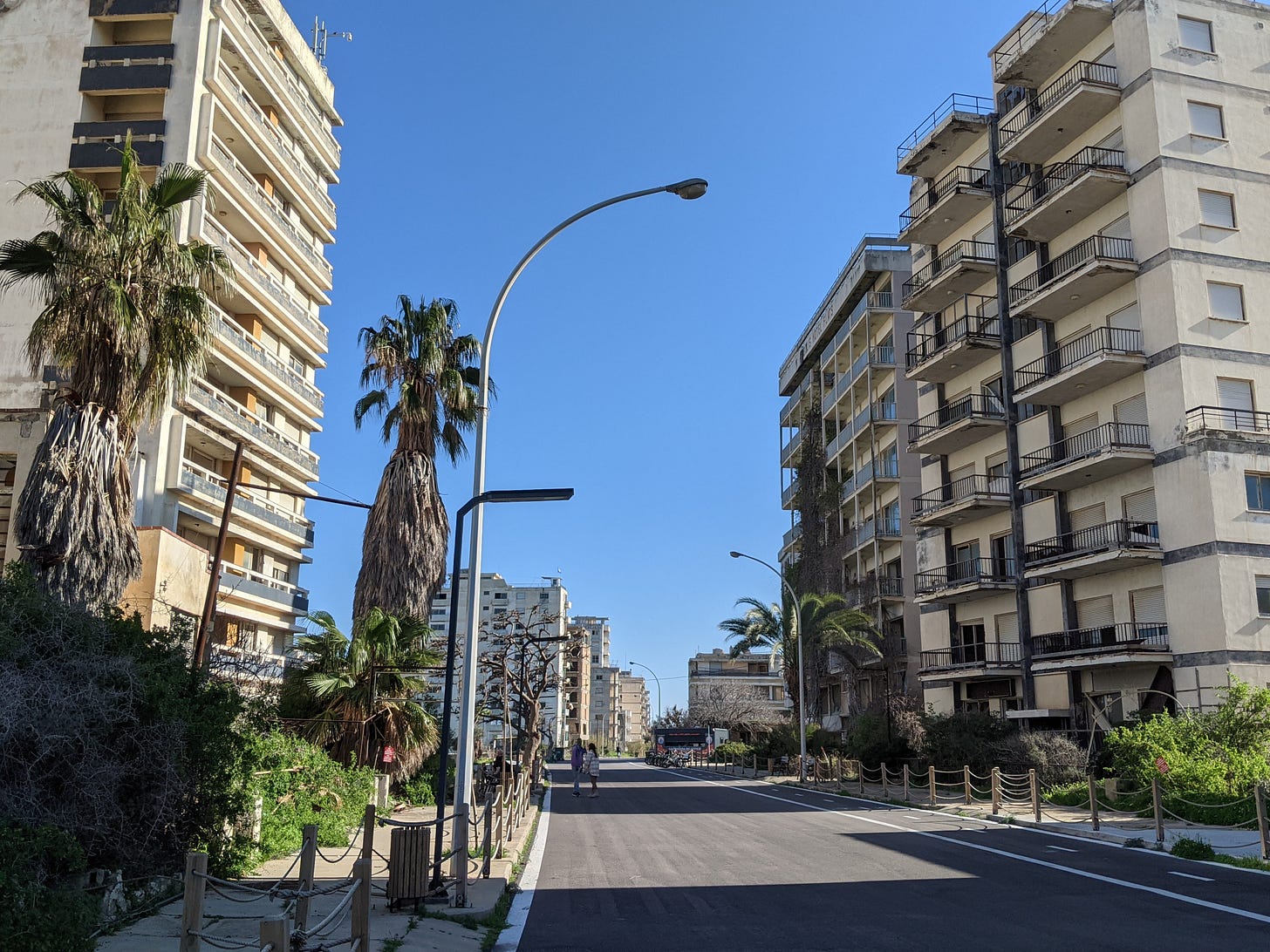
In 2014, design workshops and roundtables were held in Famagusta. Jan Wampler, an MIT architecture professor, brought 15 students from the University of South Florida to Cyprus to study the issue. There was a lot of energy in the discussions, which brought in the support of foreign embassies and the participation of Cypriots from both communities. As Markides told me:
At that point, it was exactly 40 years since Famagusta had been abandoned. And [many participants] felt like this was the first moment where they could actually see the future, and a bright future for the city. And they felt hopeful, because they were seeing young Greek and Turkish Cypriots working together…
But the futuristic discussions were not all sunny. As with everything having to do with Famagusta, and Cyprus more generally, controversy abounded. The Eco-City Project found the most resistance from the Greek Cypriot property owners of abandoned Varosha. As Markides said:
You know the big elephant-in-the-closet issue? Those giant, hideous high-rise hotels. People are so attached to these hotels, because they were the thing that brought all the wealth to the city… what they don’t understand is that no one wants to go stay in a giant concrete box anymore… Tourists want to have a unique local experience.
This was a huge issue for the vision of the Eco-City project, because the hotel ruins are, in all likelihood, no longer safe to live in—not without massive renovations. Many of them also contribute to beach erosion. To architect Jan Wampler, the hotels represent a vision of tourism that is passé. He said:
I believe that the notion of tourism [in] the [1950s] and 60s is over—Rich people going to hotels around the world—it’s got to be more sustainable. I have found that all over the world, tourism is a death sentence to places.
Wampler explained that tourism-service industries in developing countries don’t often actually promote economic development, as most of the revenue ends up in the company which owns the resorts, usually in the West. He sees the future of tourism as adventure tourism, like spending weeks working on a farm, harvesting apples, or working on fishing boats on Block Island, off the coast of Rhode Island, where Wampler spends his summers today.
Wampler’s idea is… interesting. But it seems hard to believe that the kind of tourism that Cyprus tends to attract—the hard-drinking beach tourism of predominantly British and Russian visitors—might be compatible with this vision, the vision of “paying-to-do-romantic-hard-labor” for someone else.
The attachment to the modern hotels is ironic. Like most problems on Cyprus, the problem was imported. According to a 2022 article by Panayiota Pyla and Dimitris Venizelos, Varosha was targeted and developed as a modern tourist site in the 1960s thanks to teams of economic and technical assistance from the United Nations and France. Willard Thorp, an American economist who had been previously involved in the Marshall Plan, wrote a report in 1961 at the behest of the United Nations that suggested the development of Varosha for tourism. It would be reductive to say that Varosha’s development was solely caused by these interventions, but it was surely informed by them.
As of this writing, the documentary about the eco-city project remains unfinished, seemingly just like all the visions for a new Varosha.


